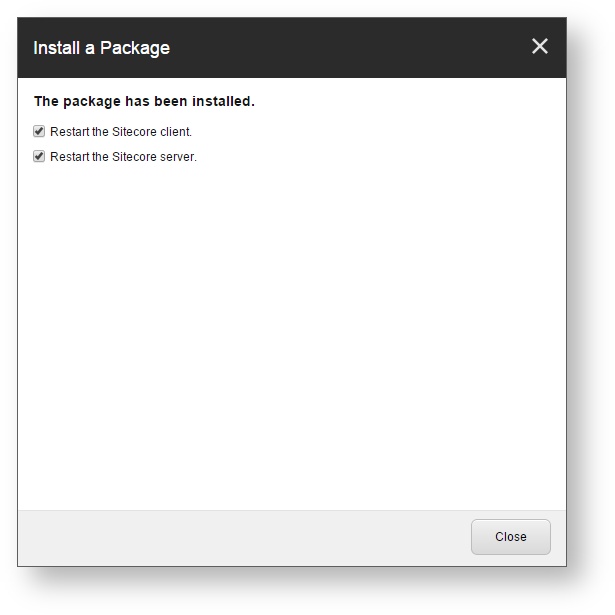September 18, 2020 release (5.0.788.5)
September 18, 2020 release (5.0.788.5)
|
|
Per the Coveo Version Support Lifecycle policy, this Coveo for Sitecore 5 release has been retired. See available Coveo for Sitecore releases. Even if this release is retired, you must still perform some of its upgrade steps to upgrade to a more recent version of Coveo for Sitecore. |
This release includes the 2.9159.8 version of the JavaScript Search Framework (see June 2020 Release (v2.9159)).
When using a CDN with the Coveo Hive framework, this release includes the latest 2.9159 version of the JavaScript Search Framework (see Choosing between local and CDN Coveo JavaScript resource files).
Release Notes
This section summarizes the new features and fixed support cases introduced in the Coveo for Sitecore September 18, 2020 release (5.0.788.5).
| Identifier | Enhancement |
|---|---|
| SC-4086 | Expose the expression property for the Coveo JavaScript Search Framework FacetValueSuggestions component data source. |
| SC-4497 | Added support for the Coveo JavaScript Search Framework SortDropdown component. |
| SC-4509 | Added support for new usage analytics endpoint. |
| SC-4543 | Provided ability to connect a Sitecore instance to Coveo organizations across all available data residency regions. |
| SC-4544 | Added support for SXA 10.0. |
| SC-4554 | Added support for Sitecore 10.0. |
| Identifier | Case | Fixed Support Case |
|---|---|---|
| SC-4551 | 00062150 | Fixed issue with Sitecore returning 127.0.0.1 as the server URL on Azure. |
| Identifier | Bug Fix |
|---|---|
| SC-4542 | Enable license parameters queryQuotaPerOrgLimit and querySuggestQuotaPerOrgLimit to be used instead of queryRateLimit. |
Upgrade Steps
|
|
Per the Coveo Version Support Lifecycle policy, this Coveo for Sitecore 5 release has been retired. See available Coveo for Sitecore releases. Even if this release is retired, you must still perform some of its upgrade steps to upgrade to a more recent version of Coveo for Sitecore. |
This section describes how to upgrade Coveo for Sitecore from August 10, 2020 (5.0.761.5) to September 18, 2020 (5.0.788.5). If you're upgrading over multiple versions, Coveo has a procedure to streamline the process.
|
|
For the best Coveo for Sitecore experience, always follow the Best Practices When Upgrading Coveo for Sitecore. |
Step 1: Upgrade Coveo for Sitecore
|
|
Make sure the Microsoft MVC security update MS14-059 is installed on every Sitecore host in your environment. |
- Log into the Sitecore Desktop.
- Access the Installation Wizard (Sitecore Start Menu > Development Tools > Installation Wizard).
- Upload and install the Coveo for Sitecore 5.0.788.5 package built for the specific version of Sitecore you're running.
- When prompted to overwrite files, click Yes to all.
-
When prompted to overwrite items, select Overwrite, then click Apply to all.
NoteYou might be prompted twice with this question. Select the Overwrite option and click Apply to all both times.
-
Once the installation is completed, make sure that you restart both the Sitecore client and server.

Step 2: Manually Update the Coveo Configuration Files
The Coveo configuration files are located in the App_Config\Include\Coveo folder. When upgrading, you must compare the changes to the .example files from your current Coveo for Sitecore version with the ones in the build you're upgrading to. Then, you can merge these changes into your current configuration files. This method let's you keep your customization intact, while still benefiting from the latest enhancements brought in the product. You can use a merge tool such as WinMerge to do this.
In further detail, here are the modifications that you must perform to the configuration files resulting from the feature changes between the previous and current Coveo for Sitecore releases:
Coveo.SearchProvider.Rest.config
The <analyticsUri> element text node has changed. The new value is https://platform.cloud.coveo.com/rest/ua. Update this setting, both in Coveo.SearchProvider.Rest.config and in the Coveo.SearchProvider.Rest.Custom.config patch file, to ensure the final configuration uses the new endpoint.
Coveo.Service.Api.IndexService.config and Coveo.Service.Api.ConfigService.config
Setting a cache expiration for storing organizations using the <fetchOrganizations> element has been moved from the Coveo.Service.Api.IndexService.config file to the Coveo.Service.Api.ConfigService.config file.
If you had manually changed the <fetchOrganizations> element value in Coveo.Service.Api.IndexService.config, ensure you set <fetchOrganizations> in Coveo.Service.Api.ConfigService.config to the same value.
Step 3: (Optional) Use queryQuotaPerOrgLimit Instead of queryRateLimit to Configure the Query Rate Limit
If you added the queryRateLimit parameter to your Coveo.SearchProvider.Rest.Custom.config file to configure the query rate limit, you should replace it with queryQuotaPerOrgLimit.
Step 4: End Use of UrlOptions and MediaUrlOptions Properties in Custom Code
The UrlOptions and MediaUrlOptions properties of the Coveo.Framework.Links.IUrlOptions and Coveo.Framework.Links.IMediaUrlOptions classes respectively have been marked as obsolete. Adjust your custom code if necessary.
Step 5: Publish your site
In the Sitecore Content Editor, perform a publish site action. This ensures any changes related to Coveo components in the upgrade are published to the web database.